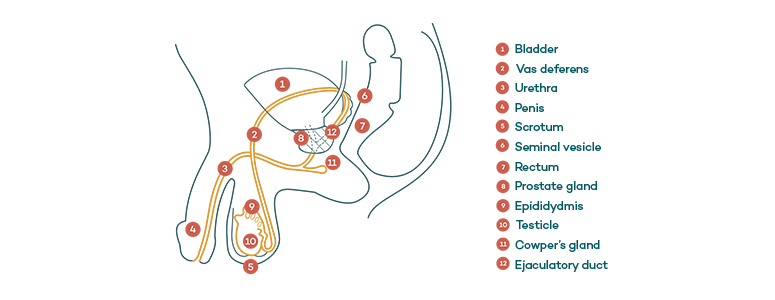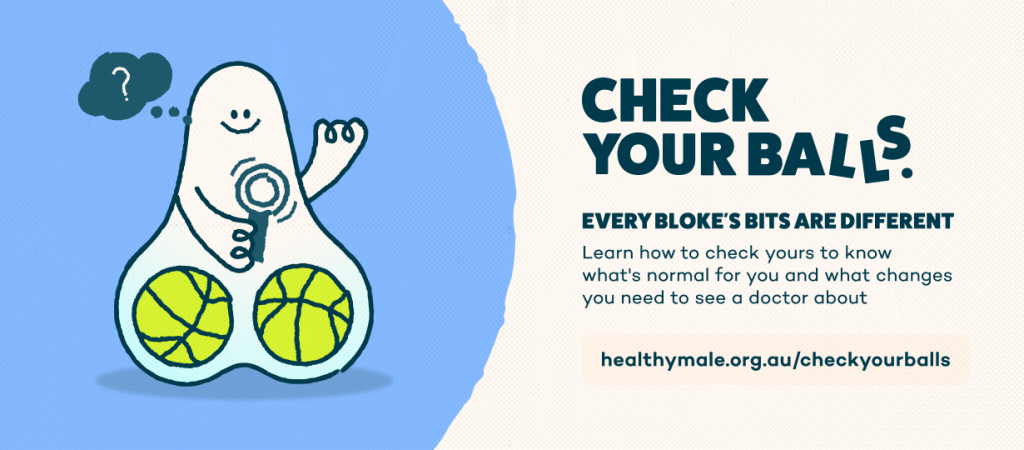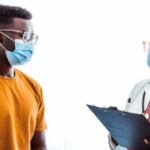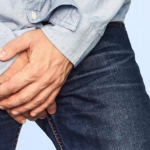Whether you’re feeling around under the car seat or having a rearrange downstairs — it’s always a little alarming to come across something you didn’t expect to be there. So, when you find a lump on your genitals, it’s natural to consider the worst-case scenario. If you want to save yourself some unnecessary stress, it’s important to understand the difference between a lump on your scrotum and a lump on your testicles.
That also means understanding where the different parts are located and what they do.
Wait… there’s a difference?
Many men consider the ‘testicles’ and ‘scrotum’ as interchangeable terms but they’re two different parts of your genitals. You could think of your testicles like groceries and your scrotum like the grocery bag that carries them.
Your testicles — which are also known as testes — are egg-shaped organs that sit beneath your penis between your legs. Testicles are responsible for making testosterone and producing sperm.
Your scrotum is a sac of skin that hangs outside of the body and is located under the penis and around the testicles. The function of the scrotum is to keep the testes at the right temperature (several degrees cooler than your body) for proper sperm production.

You can find more detail on the male reproductive system here.
So what you think is a lump on your testicles might be on the other structures on or inside the scrotum, such as the epididymis (a coiled tube that lies at the back of each testicle) or the vas deferens (the tube that connects your epididymis to your urinary tract).
What may seem like a lump on the oranges you’ve just bought might be a lump on the grocery bag or the handles.
The main difference between a scrotal lump and a testicular lump, aside from location, is what they are caused by.
Lumps in or on the scrotum
Lumps in or on the scrotum may also be referred to as ‘scrotal masses’.
Lumps on the skin of the scrotum may be caused by warts, cysts, bacterial infections, or a sexually transmitted infection.
Lumps that sit within the scrotum may be caused by an accumulation of fluids, the growth of abnormal tissue, injury, or inflammation due to infection.
Lumps in or on the testicle(s)
Lumps on the testicle(s) may also be referred to as ‘testicular lumps’.
Lumps in or on the structures surrounding the testicles and the testicles themselves may be caused by injury, infection, birth defects or as a symptom of a more serious underlying health condition, such as testicular cancer.
For example, a bacterial infection that leads to lumps that you can see on the scrotum might cause inflammation of the testicle, which you will not always be able to see, but may be able to feel.
Types of lumps in and on the scrotum
Some of the main causes of lumps in and on the scrotum include:
Hydroceles (inside the scrotum)
Hydroceles are the most common cause of lumps in the scrotum, caused by a build-up of fluids. They are usually painless but can get progressively bigger over time. Hydroceles can affect younger men if the link between the abdomen and scrotum doesn’t close properly during birth or during early development.
Hernia (inside the scrotum)
A hernia occurs when there is a bulging of an organ or tissue through an abnormal opening and an inguinal hernia is when a part of your intestine pushes through a weak spot in your groin. You’ll likely feel swelling around your scrotum, dull ache or pressure, or pain when you cough, bend or lift something heavy. This is most common in newborns or young boys, but it may also affect men later in life if they are engaged in strenuous activity such as powerlifting.
Varicoceles (inside the scrotum)
Varicoceles are the most common cause of lumps in the scrotum, they are also known as varicose veins. Varicoceles generally tend to occur on the left side.
Testicular torsion (inside the scrotum)
Testicular torsion occurs when the testicle twists within the scrotum, twisting the spermatic cord that brings blood to the testicles. This can cause swelling and severe pain, and it should be treated medical emergency as it can cut off blood flow to the testicle.
Go to the hospital as soon as you can if you experience sudden testicular pain. Testicular torsion can be caused by strenuous physical or sexual activity.
Haematocele (between the scrotum and the testicles)
A haematocele occurs where there is blood between the layers of the scrotum and testicle(s). The most common cause of a haematocele is a serious injury, such as a direct blow to the testicles.
Epididymitis (inside the scrotum and on the testicle)
Epididymitis is a painful swelling or inflammation that occurs on the epididymis, a thin tube that is connected to the testicles, within the scrotum.
Epididymitis may be caused by a bacterial or viral infection such as a sexually transmitted infection or a urinary tract infection. It may also occur due to friction against a surface like a bike seat or a saddle.
Visible lumps and bumps (on the scrotum)
If you can visibly see a lump or bump on your scrotum, it could be a wart, a symptom of a sexually transmitted infection, or an injury. Whether or not it’s causing pain or discomfort, you should go to your doctor to get checked out as soon as you can to rule out any serious health conditions.
Spermatocele (on the epididymis which is connected to the testicles)
A spermatocele which is also known as a spermatic cyst or epididymal cyst, is usually a painless, noncancerous (non-cancer causing), fluid-filled sac that forms on the epididymis.
Epididymal cysts (on the epididymis which is connected to the testicles)
Epididymal cysts are fluid-filled cysts (a tissue sac that contains clear liquid or pus). They grow from the epididymis that lives on top of the testicle. Epididymal cysts are not dangerous but if they get bigger, they can cause pain and discomfort over time.

Types of lumps on the testicles
Learn more about testicular cancer in the video below.
When to see your doctor
Seeing or feeling a lump on your genitals can be a frightening experience, but the best way to ease your fears is by booking an appointment with your doctor to get to the bottom of the problem.
Your doctor will do a physical examination to determine the cause of the lumps or swelling in the scrotum or testicles.
It’s also important to keep track of changes to your testicles and scrotum. Here are some simple habits to help you maintain general good health and hygiene.
Tips for a healthy scrotum and testicles
Check your testicles every month
In less than a few seconds you can get a feel for any lumps, swelling or changes to your testicles by rolling each testicle using your forefinger and thumb. If you notice any tenderness, enlargement, or pain, take note of the date on which you noticed the changes and call your doctor. Learn how to do testicular self-examination here.
Avoid tight pants and underpants
Wearing loose, comfortable clothing allows your scrotum to hang naturally, keeping your testicles at the ideal temperature for sperm production.
Wash regularly
It’s important to take a shower or bath every day. This helps you to keep your genital area clean and reduces your risk of bacterial infections. Once you have showered, make sure to dry your genitals thoroughly as warm wet areas can act as a breeding ground for bacteria.
Learn more about how to properly clean your penis here.
Always use protection during sex
Using protection during sex gives you the best chance of preventing sexually transmitted infections, which may affect your scrotum and testicles.
People also ask
What is a pea size lump in the scrotum?
A pea-sized lump in the scrotum could be a spermatocele, epididymal cyst, epididymitis or testicular cancer. It’s important to see a doctor about it to determine the cause.
When should I be worried about a lump in my scrotum?
If you notice any changes, you should visit your GP who will examine your genitals for any lumps or swelling.
What size is a testicular cancer lump?
Testicular cancer lumps can vary in size, but are often described as being about the size of a pea or larger.
Is a testicular tumour hard or soft?
Testicular tumours typically present as a hard lump or area of hardness in the testicle, but they can also be soft and squishy. Any changes in the testicles, whether hard or soft, should be checked by a doctor as soon as possible.














